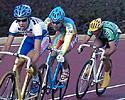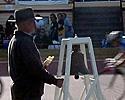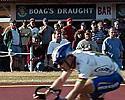
Recently on Cyclingnews.com |
Introduction to Track Racing - What's a Wheelrace? - Introduction to Six Day racing - UCI codes
What's a Wheelrace?
An Australian tradition that continues to produce champion racing - and racers
By Gerard Knapp
 |
The premier events during the Australian track racing carnivals are known as "Wheelraces". Now held for both men and women*, or combined fields depending on the carnival, Wheelraces are an Australian tradition and although non-championship events, they are always keenly contested as they have the greatest amount of prize money on offer.
A Wheelrace is a handicap event open to a wide range of riders. The race distance is typically 2000 metres if it's held in an indoor velodrome, or 3000 metres if it's an outdoor track, which is the case in many Australian towns. Riders start from a variety of positions around the track, with their handicap (or position) based on current grading and past performances. The top riders start from the 'scratch mark' - which is the absolute race distance - but they are sometimes over 300 metres behind the first riders who have that much less distance to travel. The scratch riders - normally top professionals, world champions, leading Six Day riders, etc - are the only competitors who have to cover the entire race distance.
 |
With 'head starts' provided to the majority of the field, it is always possible that the front and middle markers can get organised and work together to hold off the highly-fancied 'scratchies'. While some see this as unfair, it's an entrenched part of the sport and gives riders of all abilities to compete against the stars, with a theoretically even chance to win.
There are Wheelrace heats to determine the field for the final - where the money is to be made - and in the past some very high-profile riders have not even qualified, such is the level of competition. The finals can make for very exciting track racing, as it's basically an all-out controlled sprint requiring teamwork and in some case payoffs. For example, the 'scratchies' may arrange with each other for one or two to do the lion's share of the chasing and then blow up with a few laps to go - yet they will work hard to sit on the front and do the major effort to chase down the front and middle markers. Over the years crowds have witnessed great track riders - including olympic and world champions - pull off amazing victories by overhauling a field of 50 or more riders in the final two laps.
 |
For many observers, the Wheelrace concept is consistent with the Australian egalitarian 'fair go for all' ethic, which probably had more currency in 1903 than it does in 2003. But the tradition remains, and these wheelraces remain a major part of the Australian track racing scene since the 1890s.
Typically, they are held on outdoor tracks which are slightly banked, made of concrete and usually between 450 to 500 metres in length. They are subject to prevailing weather conditions, such as the wind, which makes for even more tactical riding. However, the capital cities and centres such as Launceston have some of the finest timber velodromes in the world.
 |
The Wheelraces are a feature event of sports carnivals which are held in many country towns throughout south eastern Australia in the summer months. At many carnivals, the cyclists race around the outside concrete track while world-class athletes limber up in the grassy infield, as the carnivals also include athletics events. When a bike race finishes, the cycling commentator hands over the microphone to the athletics commentator, who then calls what are called "Gifts", which are sprints for athletes based on the same handicap concept as the Wheelraces. In recent years, these "Gifts" have seen leading athletes such as Cathy Freeman and Maurice Green compete.
 |
Did we mention woodchopping? Yes, there's also woodchopping, where huge country blokes wield their axes into lumber in timed chopping events. Rarely is there a minute between an event of some kind being staged and as such, the carnivals have maintained their popularity for over a century. As visiting American cyclist Mike Tillman said: "fixed gear bikes, running and 'chopping - real simple. It's been like that for a hundred years, and it should stay that way."
*Wheelraces are now open to female competitors and in late 2002, Rochelle Gilmore created history by being the first female rider to qualify for a Wheelrace final in Devonport on December 30.
Do you have an article on an aspect of track cycling that you'd like to submit? Please email us with your story.
